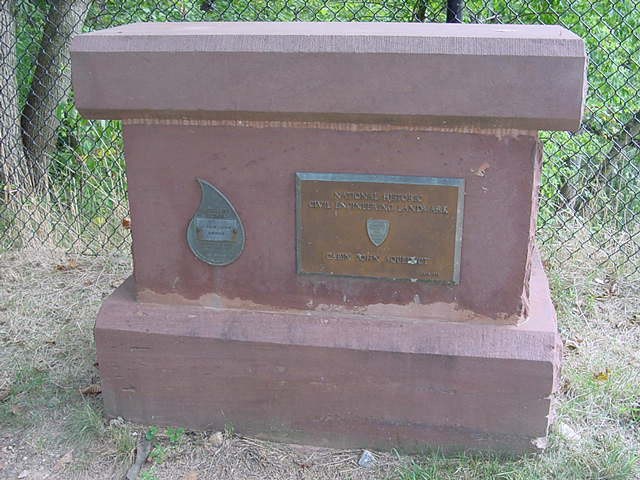Article written by C. Scheffey & B. Dennis

The Cabin John Aqueduct (Latitude 38.972779, Longitude -77.148665). [Photography by Bernie Dennis.]Following the completion of the boundary survey for the District of Columbia in 1792, development of the new city moved at a steady pace. As the city grew, relying on individual wells and springs became a source of concern. By 1850, water shortages for both consumption and fire protection were feared. Therefore, the Army Corps of Engineers was directed to conduct studies for an adequate water supply for the Nation's Capital. An officer with the Corps, Montgomery C. Meigs, was placed in charge of the studies.
Meigs' plan included a dam above Great Falls on the Potomac: a nine-foot diameter conduit and tunnel aqueduct 12 miles long, a receiving reservoir at Dalecarlia, a sedimentation reservoir in Georgetown, and a cast iron pipe distribution system. Work began in 1853, with Meigs overseeing both design and construction. The path of the aqueduct would require it to cross Cabin John Creek where Meigs conceived a multi-arch masonry aqueduct bridge.
In May 1855, Meigs hired a 25-year-old assistant engineer, Alfred L. Rives. Rives studied engineering at Virginia Military Academy (VMI) and in Paris. In 1854, he was the first American to graduate from the prestigious École des Ponts et Chaussées (EPC), noted for training the elite French corps of engineers in the mid-nineteenth century. During his studies, Rives became acquainted with the Grosvenor Bridge over the River Dee at Chester, England. Meigs also was familiar with this 200-foot long span bridge through ICE Transactions. An entry in his journal states, “This is the greatest span now standing, in stone. It is 200 feet. I should very much like to build such a one.”

Constructed in 1863, it remains in active use today.Together, Meigs and Rives evolved the aqueduct design for a single 220-foot span arch with a rise of 57.25 feet. Work began in 1857, but suffered interruptions due to lack of funds in 1859 and was eventually suspended in 1861 at the outbreak of the Civil War when Meigs and other military engineers were put to work on the fortifications of Washington. Rives, along with Secretary of War Jefferson Davis and many southern military officers, joined the ranks of the Confederacy. A revealing article on the roles of Meigs and Rives, entitled, “Alfred L. Rives and the Cabin John Bridge: Creating an Unprecedented 67m Masonry Arch at Mid-Nineteenth Century,” by Dario A. Gasparini and David A. Simmons, can be found in the Proceedings of the Third International Congress on Construction History, May 2009.
The aqueduct consists of an arch rib of dressed granite. The stones are four feet thick at the crown and six feet thick at the spring points. The spandrel walls are sandstone, backed by brick. The stone was quarried in Maryland at a site upstream on the Potomac. The quarried blocks were transported via the C & O Canal and transferred through a lock into the flooded valley under the aqueduct. Traveling cranes on timber falsework were used to place finished stone blocks. The MacArthur Blvd. roadway and coping were added 40 years later to accommodate traffic.


Following the delay due to the war, work on the structure eventually resumed and was completed in 1863. It began to carry water immediately and has been in use continuously since that time. When completed, it was the longest masonry arch span and held the record for 40 years. The American Society of Civil Engineers named it a "National Historic Civil Engineering Landmark" in 1972. The ASCE plaque shares a pedestal mount with a plaque by the American Water Work Association on the south west end of the MacArthur Blvd. single lane bridge.
